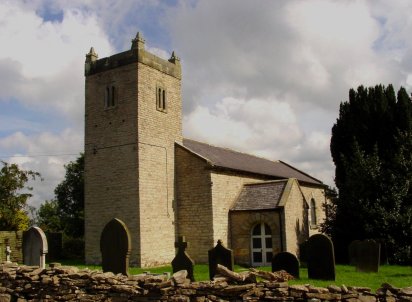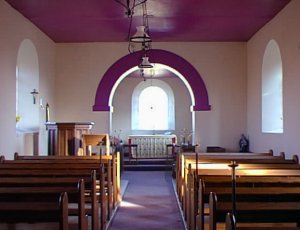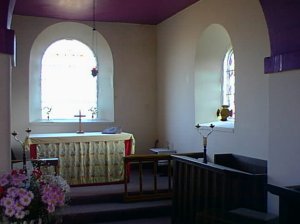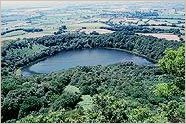
St Michael, Cold Kirby
The Church
The present building was erected in 1841. It replaced a much older church, whose origins dated back to the 12th century. The font is the original 12th century one. One of the two bells is from the 13th century. The other is dated 1665, and inscribed "God savee his church".
Originally the parish was administered by the Order of Knights Templar: a militaristic religious order whose purpose was to help defend the Christian crusader territories in the Holy Land, and which owned large tracts of land as a means of financing its fighting forces. But, after a series of defeats, the last of the crusader states was finally conquered by the Mameluke Sultans of Egypt in 1291. Shortly afterwards the king of France conspired with the Pope to have the Templars brutally suppressed, so as to sieze their wealth. Many were arrested and tortured, to extract confessions of horrible crimes; confessions which were then used to justify the suppression, which was completed in 1314.
At that point Cold Kirby passed to another order, the Knights
Hospitallers, who held it until the Reformation.
 St Michael's Church
St Michael's Church
 Inside St Michael's
Inside St Michael's
 The east end of the church
The east end of the church
The Ghost of James Tankerlay
A little glimpse of mediaeval Cold Kirby is provided by a rather odd and, unfortunately, not very edifying story about one of its priests, found in a 15th century collection of local ghost stories compiled by one of the monks of Byland Abbey. The priest in question was himself a monk from Byland, but evidently not a very good one, since he kept a concubine in the village, and when he died became a rather turbulent ghost, inspiring quite an hysterical reaction from the people. The story (discovered and translated by Dr. Richard Collins of Cork University) runs as follows:
"The old people hand down another story: The former rector of Kirby, a man called James Tankerlay, was buried amongst the Chapter of Byland, and used to come out in the night to Kirby; and one night whilst he was there he blew out the eye [!] of his concubine. And it is said that the Abbot and Convent had the body dug up out of its grave, together with its coffin, and they made Roger Wayneman carry him to Gormire, and there he threw the coffin into the water, though the oxen nearly sank in the myre for fear.
Grant that I who write these things come into no danger, for I write it as I heard it from the old people. May the Lord have mercy on him, if he was among those who are to be saved".
Gormire is the little lake which you look down on from the Cleveland Way, just north of Sutton Bank; enclosed by a dark wood, and with a reputation in local folklore of being bottomless.
 Gormire
GormireThe Drove Road
The lane running north-south along the western edge of the parish was once part ridgeway, the Hambleton drove road.
Various armies have passed this way: notably William the Conqueror's troops in 1069, in their ravaging of the north, and Edward II's, fleeing from the Scots in 1322.
For centuries the road was a major thoroughfare for Scots drovers, bringing Galloway and West Highland cattle down to Malton and York markets: over 30,000 each year in the mid-18th century. In 1802 Dorothy and William Wordsworth came walking through, and in her diary Dorothy records how, on Sutton Bank, "the little Scotch cattle panted and tossed fretfully about".
Vast flocks of sheep were also driven along the road; as well as pigs, geese and turkeys. Collie dogs helped control the herds. Sometimes, when their owners were delayed by business, they were released to find their own way home. They would be fed and housed at the droving inns and farms along the road; for which the drover would duly pay on his next journey south.
The Hambleton Races
During the 17th and 18th centuries, the area between Sutton Bank and Dialstone Farm was one of the chief racecourses in England, "the Newmarket of the North". Both Queen Anne and George I gave gold cups to be competed for here. During this period Cold Kirby would have been regularly full of jockeys and stable hands. Many of the gentry stayed in the big coaching inns of Helmsley or Thirsk. But there were also several other inns up here, to cater to the race-going public, including the Hambleton Inn and the Hare Inn at Scawton. No doubt there was a certain amount of cockfighting, too, at these various establishments.
John Wesley is said to have come here and preached - denunciation, one would guess, of gambling and drunkenness.
The training of race horses in the area continued despite the demise of the racecourse and recently Hambleton House has become the base for trainer Bryan Smart.
Upper Ryedale Parish
In 2024 Cold Kirby church, having previously been a parish united with Scawton, and then incorporated into the Upper Ryedale parish, was closed. Although it covers such a large area the total population of the parish numbers not much more than 450.
Home Page The Five Churches The Poetry Church Service Times About the Parish
Who's Who Tracing Your Ancestors Local History Hawnby Dreamers Useful Links